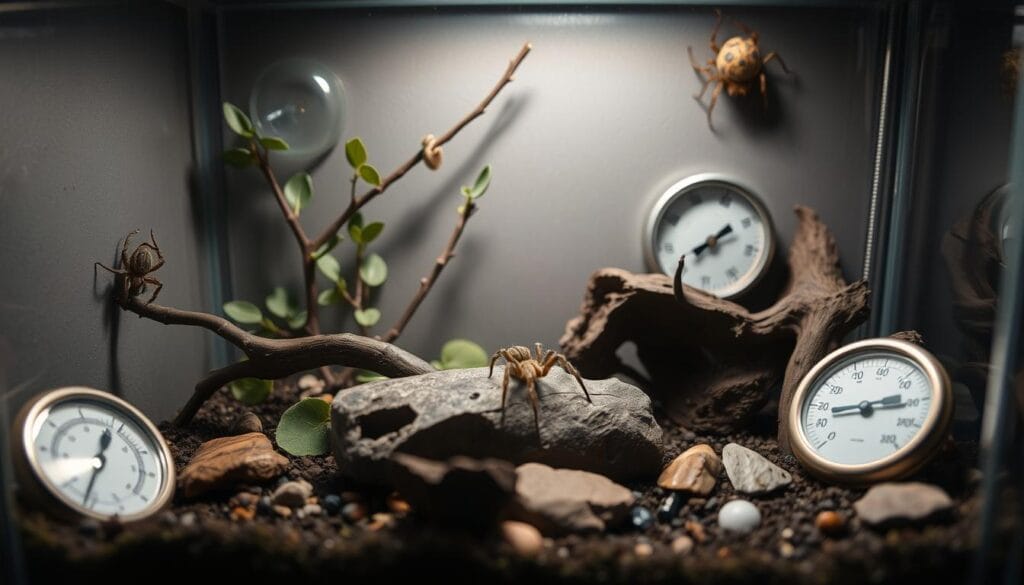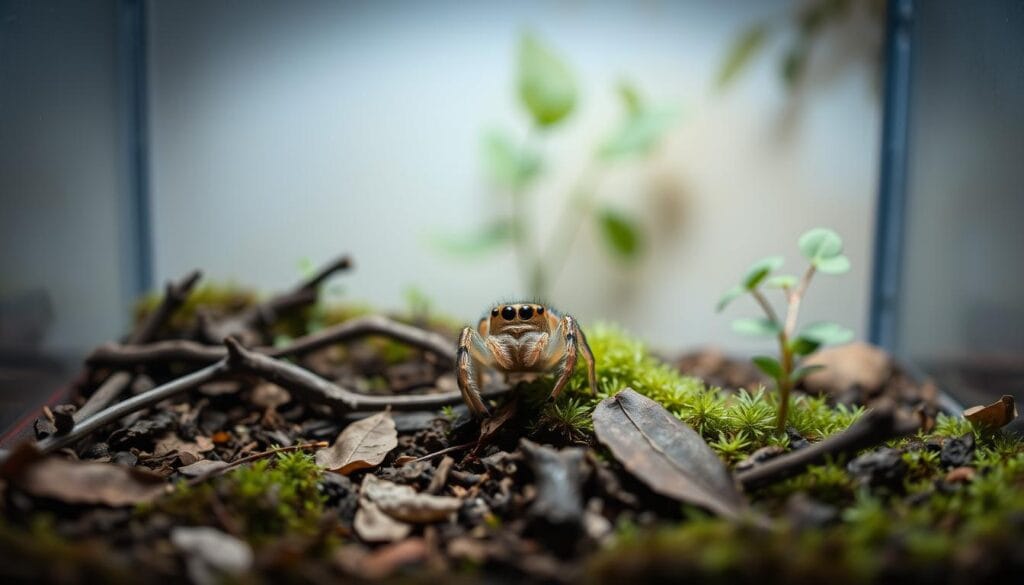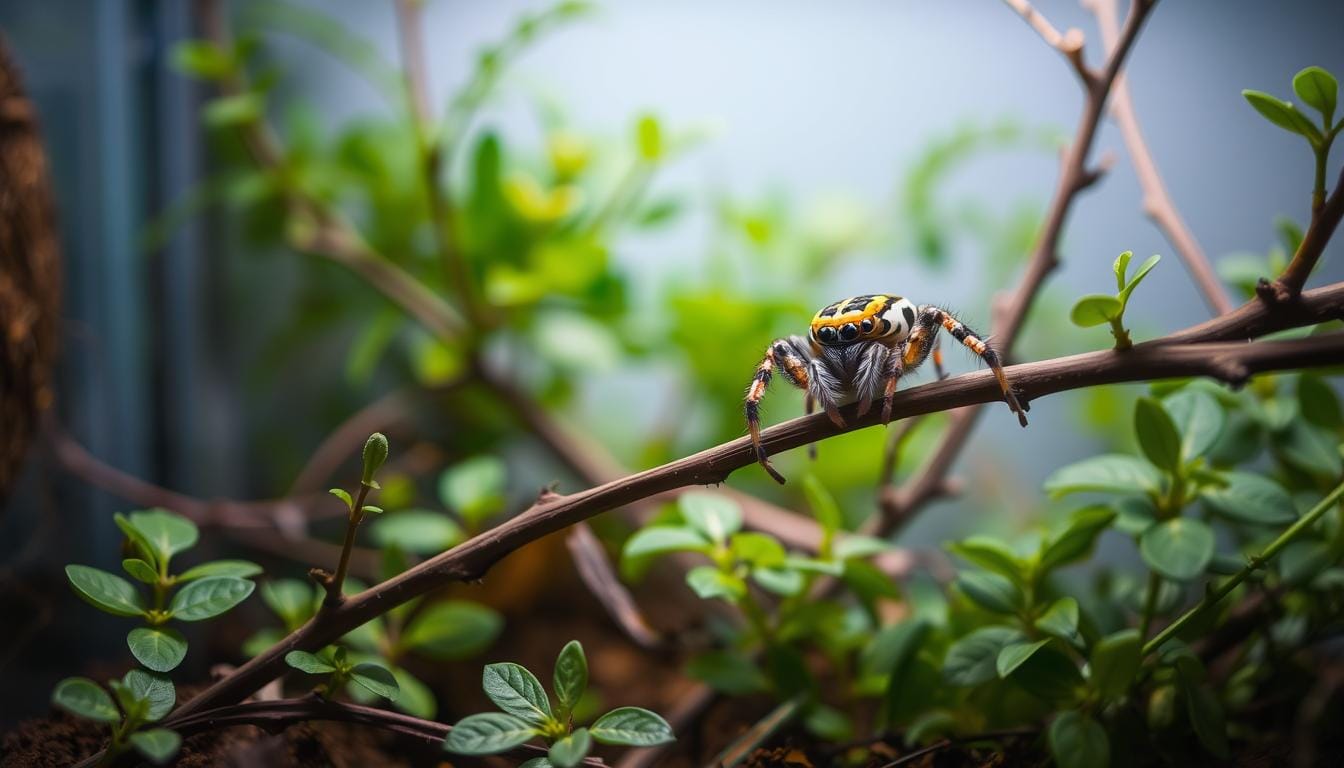Setting up a terrarium for your pet spider is fun and rewarding. It ensures your small jumping spider stays happy and healthy.
This guide will show you how to pick the perfect terrarium size. You’ll also learn about the must-haves for a great setup. Plus, we’ll cover keeping the right temperature and humidity levels.
Table of Contents
Introduction to Small Jumping Spiders
Small jumping spiders are full of surprises. They are intelligent and curious. These spiders are popular pets because of their cool jumping ability and interesting behaviors.
To care for these spiders, we need to understand what makes them special. We also need to know about their natural habitat.
What Makes Jumping Spiders Unique?
Jumping spiders can jump really well. They use this skill to catch prey and move around. They have great eyesight, with some having four pairs of eyes for almost 360-degree vision.
This amazing vision helps them spot prey and dangers from all sides. For more on their behaviors, check out exoticpethaven.com.
Overview of Their Natural Habitat
Jumping spiders live in many places, like deserts, forests, and gardens. They are found on every continent except Antarctica. They are most common in warm and tropical areas.
In their natural home, they jump between plants, on walls, or on the ground. They are very agile.
To create a good terrarium, we need to mimic their natural environment. This means choosing the right soil, adding hiding spots, and keeping the right temperature and humidity.
| Habitat Type | Characteristics | Terrarium Replication |
|---|---|---|
| Desert | Dry, sandy soil; sparse vegetation | Dry substrate; minimal plants |
| Forest | Moist, rich soil; dense vegetation | Moist substrate; plants and branches |
| Garden | Varied; often with flowers and leaf litter | Mixed substrate; flowers and leaf litter |
Choosing the Right Terrarium Size
When it comes to keeping small jumping spiders, the terrarium size is key. A good terrarium looks great and keeps your spider happy and active.
For a DIY spider terrarium, knowing the right size is crucial. A terrarium that’s too small can limit the spider’s movement. On the other hand, one that’s too big might make it hard for the spider to find food or feel safe.
Ideal Dimensions for Small Jumping Spiders
The best terrarium size for small jumping spiders is usually between 5 to 10 gallons. This size lets the spider move, spin webs, and hunt easily. For example, a terrarium that’s 12 inches long, 8 inches wide, and 8 inches tall is good for one adult spider.
Considerations for Vertical vs. Horizontal Space
Jumping spiders love to jump and move more horizontally than up and down. So, a terrarium with more horizontal space is better. But, some height is needed for good air flow and to fit plants or decorations.
For more tips on making a great invertebrate terrarium, check out this guide. It has lots of advice for making a great home for your jumping spider.
Think about both the size and layout of your terrarium. This way, you can make a DIY spider terrarium that’s both useful and looks good. It will help keep your small jumping spider happy and healthy.
Essential Terrarium Setup
Starting a thriving terrarium for your small jumping spider is key. A good spider tank setup is more than size. It’s about making a habitat that feels like home.
The substrate is crucial in a small pet spider tank. It’s the floor and affects humidity and health.
Substrate Options for Jumping Spiders
There are many substrates to choose from, each with its own benefits and drawbacks. Here are a few:
- Coconut fiber: Keeps moisture well, great for humidity.
- Peat moss: Also keeps moisture, helps keep the environment stable.
- Sand: Can be used but might cause breathing problems for spiders.
- Reptile carpet: Easy to clean, good for dry environments.
| Substrate Type | Moisture Retention | Ease of Cleaning |
|---|---|---|
| Coconut Fiber | High | Moderate |
| Peat Moss | High | Moderate |
| Sand | Low | Easy |
| Reptile Carpet | Low | Easy |
How to Include Essential Hiding Spots
Jumping spiders need places to hide and feel safe. Adding hiding spots is vital for their well-being. Use rocks, plants, and small containers for hiding places. For more tips on setting up a jumping spider enclosure, check out this jumping spider enclosure setup guide.
Temperature and Humidity Requirements
To create a good home for your jumping spider, you need to know its temperature and humidity needs. Jumping spiders live best in certain conditions that match their natural homes.
Optimal Temperature Ranges
The best temperature for most jumping spiders is between 65°F to 85°F (18°C to 30°C). Some might need a bit different temperatures. It’s key to find out what your spider likes. Use a spider terrarium accessories like a digital thermometer to keep the temperature right.
“Keeping the temperature right is very important. Jumping spiders don’t like extreme temperatures. If it’s too hot or cold, they can get sick or even die,” says an expert in caring for arachnids.
Maintaining Humidity Levels
It’s also important to keep the humidity just right. Jumping spiders like a humidity of 60% to 80%. You can use spider terrarium accessories like humidifiers or misting systems. Just misting the terrarium with water can help keep it humid.

But, don’t mist too much. Too much water can cause mold. To keep the humidity stable, use a hygrometer. This tool shows you the moisture level in the terrarium. Check the terrarium often to make sure the temperature and humidity are just right for your spider.
Lighting for Your Jumping Spider
Getting the lighting right is key for your jumping spider’s health and happiness. It’s not just about seeing them; it affects their day-night cycle and overall well-being.
Importance of Lighting in the Terrarium
Lighting in a jumping spider terrarium does more than just light it up. It helps create a day-night cycle that’s vital for your spider’s health and behavior. It also makes the terrarium look better, making it more fun to watch your spider.
Key benefits of proper lighting include:
- Regulation of the spider’s circadian rhythms
- Enhancement of the terrarium’s visual appeal
- Support for the spider’s natural hunting and resting behaviors
Choosing the Right Light Source
Choosing the right light for your jumping spider terrarium is important. It depends on your spider’s needs and your terrarium’s setup.
Some popular lighting options include:
- LED lights: Energy-efficient and produce minimal heat
- Fluorescent lights: Provide a broad spectrum of light and are gentle on the spiders
- Low-wattage incandescent bulbs: Can be used but may require more frequent replacement
Make sure to pick a lighting solution that meets your jumping spider’s needs. This will help keep them healthy and happy.
Food and Diet for Small Jumping Spiders
To keep your small jumping spider healthy, it’s vital to understand its dietary needs. A well-balanced diet is crucial for the spider’s overall health and well-being. In a small critter enclosure, providing the right food is essential.
Recommended Diet Choices
Small jumping spiders are carnivorous and feed on live insects. For a balanced diet, you can offer them a variety of prey such as fruit flies, aphids, and small crickets. It’s essential to provide prey that is appropriately sized for your spider to ensure they can capture and consume it easily.
The dietary needs of jumping spiders can vary based on their age and size. Younger spiders may require smaller prey like pinhead crickets or tiny aphids, while larger spiders can be fed larger crickets or other insects. Ensuring a diverse diet will help keep your spider healthy and thriving.

Feeding Frequency and Techniques
The frequency of feeding depends on the age and size of your jumping spider. Generally, younger spiders need to be fed more frequently than adults. A common practice is to feed them every other day, adjusting the frequency based on their appetite and growth rate.
When feeding, it’s crucial to remove any uneaten prey from the enclosure to prevent it from stressing your spider or causing mold and bacterial growth. Using a feeding tool or tweezers can help in presenting the prey to your spider, making the feeding process more efficient.
| Spider Age | Feeding Frequency | Recommended Prey |
|---|---|---|
| Juvenile | Every other day | Pinhead crickets, aphids |
| Adult | 2-3 times a week | Small crickets, fruit flies |
By understanding and implementing the right feeding strategies, you can ensure your small jumping spider leads a healthy and active life in its small critter enclosure.
Health Care and Maintenance
To keep your jumping spider healthy, it’s important to know the signs of good health. You also need to know how to fix any problems. A clean terrarium that looks like the spider’s spider habitat is key for its health.
Signs of a Healthy Jumping Spider
A healthy jumping spider is active and eats well. It should look shiny and be alert. Check your spider often to see if it’s healthy.
- Vibrant coloration
- Active movement
- A healthy, rounded abdomen
If your spider looks dull or is very slow, it might be sick. This could mean it’s not getting the right food or living space.
Common Health Issues and Solutions
Jumping spiders can get sick with dehydration, parasites, and molting problems. Knowing how to fix these issues is important for your spider’s health.
| Health Issue | Signs | Solution |
|---|---|---|
| Dehydration | Dry appearance, lethargy | Increase humidity, ensure water availability |
| Parasites | Visible mites or flies, spider stress | Isolate the spider, clean the terrarium, treat for parasites |
| Molting Problems | Stuck during molting, incomplete molt | Maintain optimal humidity, ensure a stress-free environment |
Watching your spider closely and having a good spider habitat can stop many problems. If you see any health issues, fix them quickly to keep your spider happy and healthy.
Handling Your Jumping Spider
Handling your jumping spider can be fun and rewarding. But, it’s important to do it safely and responsibly. This ensures a positive experience for both you and your spider.
Safe Handling Techniques
When handling your jumping spider, be gentle. Let your spider crawl onto your hand instead of picking it up. This helps avoid hurting your spider.
Make sure your hands are clean. Avoid soap or chemicals that could harm your spider.
- Move slowly and deliberately to avoid startling your spider.
- Support your spider’s body as it moves across your hand.
- Avoid sudden movements or loud noises.
When to Avoid Handling
There are times when you should not handle your jumping spider. After feeding, your spider may be more aggressive or stressed. Also, during molting or when your spider is preparing to molt, handling should be avoided as it can cause undue stress.
- Avoid handling when your spider is showing signs of stress or agitation.
- Refrain from handling during the spider’s molting cycle.
- Do not handle your spider when it’s hungry or immediately after feeding.
By following these guidelines, you can enjoy handling your jumping spider. This ensures its well-being and safety in its spider enclosure.
Breeding Jumping Spiders in Captivity
To breed jumping spiders, you must understand their needs and create a good terrarium. Breeding them can be rewarding but needs careful planning and detail.
Setup for Breeding
Creating a breeding terrarium means making a space like their natural home. You need to keep the right temperature and humidity. Also, provide hiding spots and substrates. A terrarium with good air flow and a secure lid is key to keep them safe and healthy.
Key considerations for a breeding terrarium setup:
- Maintain a temperature range of 65-75°F (18-24°C)
- Keep humidity levels between 50-60%
- Use a substrate like coconut fiber or peat moss
- Include plants and hiding spots for the spiders
Caring for Spiderlings
After the eggs hatch, spiderlings need special care. They need a safe, escape-proof place with the right substrate and humidity. Feeding them small prey like fruit flies or tiny crickets is important for their growth.
As noted by arachnid experts, “Spiderlings require precise care, including a nutritious diet and a clean environment, to thrive.”
Watching the spiderlings grow and stay healthy is crucial. As they get bigger, they might need to be kept apart to stop them from eating each other. With the right care, they can grow into strong adult jumping spiders.
Fun Facts About Small Jumping Spiders
Small jumping spiders have many interesting facts and traits. They are fascinating to watch and can be great pets for the right owner.
Interesting Behaviors and Traits
These spiders have amazing jumping skills. They use this to catch prey and avoid danger. They can jump several times their own body length. Males also do cool dances to attract females.
Jumping spiders have great eyesight. They can see in many directions with their eight eyes. This helps them find food and move around.
Benefits of Keeping Jumping Spiders as Pets
Keeping small jumping spiders as pets is rewarding. They are easy to care for. You need a well-ventilated terrarium, the right food, and to keep the temperature right.
Watching these spiders can teach you a lot. You can learn about their life, how they hunt, and their web-building habits. Following spider keeping tips can make your experience better and keep your pet happy.
| Benefit | Description |
|---|---|
| Low Maintenance | Jumping spiders require less care compared to traditional pets, making them ideal for busy individuals. |
| Educational | Observing jumping spiders can provide insights into their behavior, life cycle, and habitat. |
| Unique Interaction | For those comfortable with handling arachnids, jumping spiders can offer a unique interactive experience. |
Understanding these amazing creatures can make keeping a small jumping spider as a pet rewarding. You’ll not only have a friend but also learn more about nature.
Resources for Further Learning
As you care for your small jumping spider, you might want to learn more. There are many resources to help you create the best home for your pet.
Recommended Resources
Books and websites about arachnids are full of useful info. Online forums and websites have guides for setting up a terrarium. These resources can improve your skills and keep you up-to-date with care techniques.
Joining a Community
Connecting with other jumping spider fans is a great idea. Online communities and forums let you ask questions and share knowledge. By joining, you can learn how to make your spider’s tank happy and healthy.

